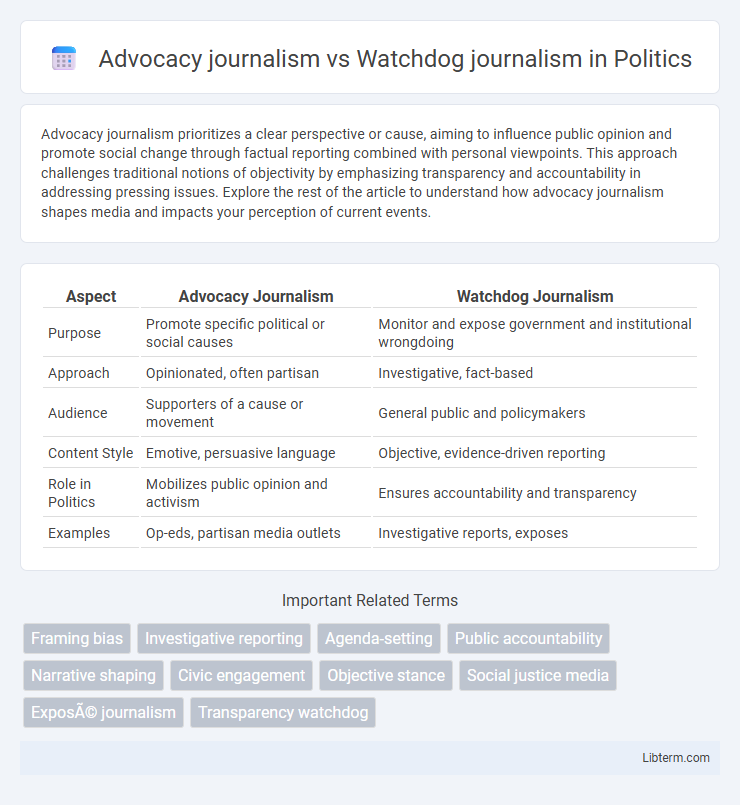Advocacy journalism prioritizes a clear perspective or cause, aiming to influence public opinion and promote social change through factual reporting combined with personal viewpoints. This approach challenges traditional notions of objectivity by emphasizing transparency and accountability in addressing pressing issues. Explore the rest of the article to understand how advocacy journalism shapes media and impacts your perception of current events.
Table of Comparison
| Aspect | Advocacy Journalism | Watchdog Journalism |
|---|---|---|
| Purpose | Promote specific political or social causes | Monitor and expose government and institutional wrongdoing |
| Approach | Opinionated, often partisan | Investigative, fact-based |
| Audience | Supporters of a cause or movement | General public and policymakers |
| Content Style | Emotive, persuasive language | Objective, evidence-driven reporting |
| Role in Politics | Mobilizes public opinion and activism | Ensures accountability and transparency |
| Examples | Op-eds, partisan media outlets | Investigative reports, exposes |
Defining Advocacy Journalism
Advocacy journalism is a style of journalism that openly promotes a specific political or social cause, aiming to influence public opinion and policy through persuasive storytelling and selective presentation of facts. It differs from watchdog journalism, which primarily focuses on investigating and exposing wrongdoing without an explicit agenda. Advocacy journalism often blends reporting with activism, using emotional appeals and opinionated narratives to advance its objectives.
Understanding Watchdog Journalism
Watchdog journalism plays a critical role in holding power accountable by investigating and exposing corruption, abuse, and malpractice within government and corporate sectors. It prioritizes impartiality and factual accuracy, aiming to inform the public and drive systemic change through thorough research and evidence-based reporting. Unlike advocacy journalism, which openly supports specific causes or viewpoints, watchdog journalism maintains a role as a neutral observer dedicated to transparency and accountability.
Historical Background of Both Approaches
Advocacy journalism emerged prominently in the early 20th century as journalists sought to promote social and political causes, aligning their work with specific ideologies to influence public opinion and policy. Watchdog journalism traces back to the 18th-century Enlightenment era, rooted in the press's role as a guardian of democracy by scrutinizing government actions and exposing corruption. Both approaches evolved through distinct historical contexts, with advocacy journalism championing activism and watchdog journalism emphasizing accountability.
Core Objectives and Principles
Advocacy journalism centers on promoting a specific political or social cause, aiming to influence public opinion and policy through clearly articulated viewpoints and passionate storytelling. Watchdog journalism focuses on investigating and exposing corruption, abuse, and inefficiency, upholding accountability and transparency in public institutions without partisan bias. Both prioritize truth and public interest, but advocacy journalism openly aligns with advocacy goals, while watchdog journalism maintains impartial scrutiny to protect democratic processes.
Methods and Techniques in Practice
Advocacy journalism employs persuasive storytelling, emotive language, and strategic framing to promote a particular viewpoint, often using interviews, opinion pieces, and investigative reports to influence public opinion. Watchdog journalism relies on rigorous fact-checking, in-depth investigation, and transparency to hold powerful entities accountable, utilizing data analysis, document examination, and whistleblower sources to expose wrongdoing. Both methods prioritize transparency and accuracy but differ in their primary objectives: advocacy journalism aims to drive social change, while watchdog journalism seeks to provide oversight and ensure accountability.
Ethical Considerations and Challenges
Advocacy journalism commits to promoting specific social or political causes, raising concerns about maintaining objectivity and potential bias in reporting. Watchdog journalism prioritizes holding power accountable with a focus on truth and transparency, yet faces challenges in balancing aggressive investigation with ethical standards like accuracy and fairness. Both forms must navigate the ethical tension between informing the public and avoiding partisanship while upholding journalistic integrity.
Impact on Public Opinion and Policy
Advocacy journalism actively promotes specific political or social causes, shaping public opinion by presenting biased perspectives aligned with its agenda, which often mobilizes targeted audiences for policy change. Watchdog journalism, by contrast, focuses on investigative reporting to expose corruption, abuse, and inefficiencies, fostering transparency and accountability that influence policymakers through evidence-based revelations. Both forms impact public opinion and policy, but advocacy journalism drives change through persuasive narratives, while watchdog journalism relies on factual scrutiny to prompt reform.
Notable Examples and Case Studies
Advocacy journalism is exemplified by outlets like The Guardian, which often champions social justice causes through investigative reports, while watchdog journalism is embodied by institutions such as ProPublica, focusing on exposing government corruption and corporate malfeasance. The Pentagon Papers case, uncovered by The New York Times, stands as a landmark example of watchdog journalism revealing government secrecy during the Vietnam War. Similarly, advocacy journalism is highlighted by the coverage of the Black Lives Matter movement in media like The Intercept, which blends activism with rigorous reporting to influence public policy.
Audience Trust and Credibility Issues
Advocacy journalism, which openly supports a specific cause or viewpoint, often faces scrutiny regarding its impartiality, resulting in varying levels of audience trust and potential credibility challenges. Watchdog journalism prioritizes uncovering wrongdoing and holding power accountable, fostering higher credibility and generally greater trust among audiences due to its commitment to factual accuracy and independence. Maintaining transparency about biases and rigorous fact-checking are critical for both types to sustain audience trust and uphold journalistic integrity.
The Future of Advocacy and Watchdog Journalism
Advocacy journalism increasingly leverages digital platforms to mobilize public opinion and influence policy through targeted storytelling and social media engagement. Watchdog journalism, empowered by advancements in data analysis and real-time monitoring technologies, enhances transparency and accountability by uncovering corruption and systemic issues. The future of both fields depends on integrating technological innovation with ethical standards to sustain public trust and democratic processes.
Advocacy journalism Infographic

 libterm.com
libterm.com